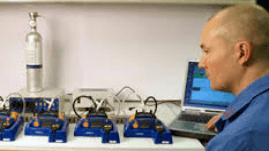Differential Pressure Switch: Function, Applications & Benefits for Industrial Safety
A differential pressure switch is a critical component in many industrial systems, designed to monitor and respond to differences in pressure between two points. Commonly used in HVAC, filtration, pumping, and process control systems, differential pressure switches help protect equipment, maintain efficiency, and ensure workplace safety.
What Is a Differential Pressure Switch?
A differential pressure switch senses the difference in pressure between two input sources. When this difference exceeds or falls below a preset limit, the switch activates, triggering an alarm, shutting off equipment, or initiating other control actions. This automatic response helps prevent damage to machinery, contamination, and unsafe conditions.
How Does a Differential Pressure Switch Work?
The switch includes two pressure ports connected to different points in a system. When the pressure difference crosses a defined threshold, an internal mechanism (mechanical or electronic) actuates a contact, opening or closing an electrical circuit. This signal can be used for safety shutdowns, alerts, or system automation.
Key Applications of Differential Pressure Switches
-
HVAC Systems
Monitors airflow and filters to detect clogs or blockages and maintain proper ventilation. -
Industrial Filtration
Identifies dirty or overloaded filters to signal replacement or cleaning, preventing system strain. -
Pump Monitoring
Protects pumps from conditions like cavitation or dry running by detecting abnormal pressure changes. -
Cleanrooms and Laboratories
Ensures correct pressure differentials between rooms to prevent contamination or maintain sterile environments. -
Oil & Gas and Petrochemical Plants
Monitors pressure across membranes, filters, or pipelines to ensure efficient and safe operation.
Benefits of Using a Differential Pressure Switch
-
Enhances equipment safety and longevity
-
Reduces maintenance costs through early fault detection
-
Improves process efficiency by maintaining optimal pressure conditions
-
Offers fast response in critical systems
-
Suitable for both liquid and gas applications
Features to Consider When Choosing a Differential Pressure Switch
-
Pressure range and setpoint adjustability
-
Type of media (air, water, oil, chemicals)
-
Temperature and environmental resistance
-
Electrical output type (SPDT, DPDT, analog, digital)
-
Certification needs (ATEX, IECEx for hazardous areas)
Conclusion
A differential pressure switch may seem like a small device, but it plays a significant role in maintaining the safety, efficiency, and performance of industrial systems. From HVAC and filtration to energy and chemical processing, these switches ensure that pressure differences are constantly monitored and controlled.


